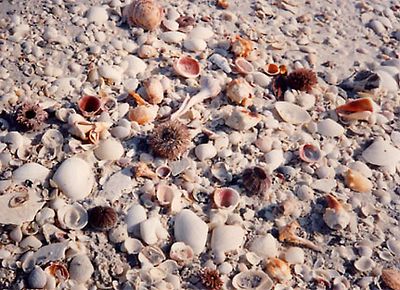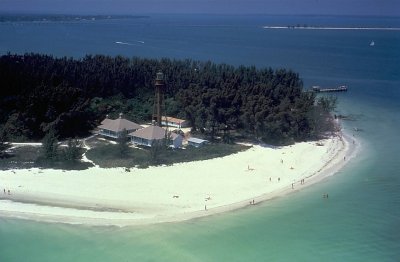Discover Florida Nature
It's time to explore the natural Florida


|
|
|
|
|
 Sanibel
Island, the seashell capital of the world is an island located on the
Gulf coast of Florida, just offshore of Fort Myers. Located within Lee
County, Sanibel is a barrier island – a collection of sand on the
leeward side of the Gulf Stream from the more solid coral-rock of Pine
Island. Sanibel Island is world renowned for its shelling beaches and
the "Sanibel Stoop". In the travel industry Sanibel Island is a top
Florida destination for visitors. Sanibel Island has breathtaking white
sand beaches and clear blue water and an abundance of colorful shells -
"treasures from the sea." Sanibel
Island, the seashell capital of the world is an island located on the
Gulf coast of Florida, just offshore of Fort Myers. Located within Lee
County, Sanibel is a barrier island – a collection of sand on the
leeward side of the Gulf Stream from the more solid coral-rock of Pine
Island. Sanibel Island is world renowned for its shelling beaches and
the "Sanibel Stoop". In the travel industry Sanibel Island is a top
Florida destination for visitors. Sanibel Island has breathtaking white
sand beaches and clear blue water and an abundance of colorful shells -
"treasures from the sea."Sanibel and Captiva formed as one island about 6000 years ago. The first humans in the area were the Calusa, who arrived about 2500 years ago. The Calusa were a powerful Indian nation who came to dominate most of southwest Florida through trade and their elaborate system of canals and waterways. Sanibel remained an important Calusa settlement until the collapse of their empire, soon after the arrival of the Europeans. The city of Sanibel incorporates the entire island, with most of the city proper at the east end of the island. The community of Santiva, a portmanteau of Sanibel and Captiva, is at the northwestern end of the island. After the Sanibel causeway was built to replace the ferry in May 1963, the residents fought back against overdevelopment by establishing the Sanibel Comprehensive Land Use Plan in 1974 helping to maintain a balance between development and preservation of the island's ecology. A new, higher bridge without a bascule (drawbridge) having to open for tall boats and sailboats, was completed in late 2007. More than half of the island is made up of wildlife refugees, the largest one is the J.N. "Ding" Darling National Wildlife Refuge. The refuge is part of the largest undeveloped mangrove ecosystem in the United States. It is world famous for its spectacular migratory bird populations. The best months to visit for birding are December through March. It's always best to coordinate a visit around a low tide when the birds are feeding on the exposed mud flats. Many events happen throughout the year on the refuge, which can make a visit that much more enjoyable.  The
island's curved shrimp-like shape forms Tarpon Bay on the north side of
the island. It is linked to the mainland by the Sanibel Causeway, which
runs across two small manmade islets and the
Intracoastal Waterway.
A short bridge links Sanibel Island to
Captiva Island over Blind Pass. The Gulf side beaches are excellent
on both islands, and are world renowned for their variety of seashells,
which include coquinas, scallops, whelks, and other deeper-water
mollusks. You may collect sand dollars but first check to make sure that
the sand dollar is not alive - turn it over - there are little centipede
feet up and down the backside - gently touch them with your finger to
see if they move and its alive. If alive gently place back into the
water and if they do not move, then you have just found one of our
islands treasures! To bleach a sand dollar white it is important to soak
in fresh water first. Water will be a brownish color, change water
frequently until fairly clear or just continually flush with water until
water stays fairly clear. Soak in a 50/50 solution of bleach and water
for 5-10 minutes. Caution: Do not soak too long in bleach solution as
sand dollar may crumble. Rinse thoroughly, let dry preferably in sun to
bleach further. To harden sand dollar for crafts or display: Mix equal
portions of white glue and water. With paint brush cover sand dollar
with mixture. Let dry. The
island's curved shrimp-like shape forms Tarpon Bay on the north side of
the island. It is linked to the mainland by the Sanibel Causeway, which
runs across two small manmade islets and the
Intracoastal Waterway.
A short bridge links Sanibel Island to
Captiva Island over Blind Pass. The Gulf side beaches are excellent
on both islands, and are world renowned for their variety of seashells,
which include coquinas, scallops, whelks, and other deeper-water
mollusks. You may collect sand dollars but first check to make sure that
the sand dollar is not alive - turn it over - there are little centipede
feet up and down the backside - gently touch them with your finger to
see if they move and its alive. If alive gently place back into the
water and if they do not move, then you have just found one of our
islands treasures! To bleach a sand dollar white it is important to soak
in fresh water first. Water will be a brownish color, change water
frequently until fairly clear or just continually flush with water until
water stays fairly clear. Soak in a 50/50 solution of bleach and water
for 5-10 minutes. Caution: Do not soak too long in bleach solution as
sand dollar may crumble. Rinse thoroughly, let dry preferably in sun to
bleach further. To harden sand dollar for crafts or display: Mix equal
portions of white glue and water. With paint brush cover sand dollar
with mixture. Let dry.The Island also hosts the Sanibel Historical Village and a variety of other museums and theaters. The Bailey-Matthews Shell Museum is the only museum in the world dedicated to the study of shells. The non-profit Bailey-Matthews Shell Museum features more than 30 exhibits of mollusks from around the world. Exhibits are devoted to shells in art and history, shell habitat, rare specimens, fossil shells, common Southwest Florida shells, and more. The learning lab features a hands-on play area for children, displays, games, and a tank with indigenous mollusks. A half-hour video, Mollusks in Action, is shown on the hour, and a children's video is shown continuously. The museum store offers a wide selection of shell books. In August 2004 Hurricane Charley hit the island causing mandatory evacuation for the island's residents and resulting in the most damage done to the island in 44 years. |
|
|
Sanibel Island Florida
Sanibel Island, the seashell capital of the world is an island located on the Gulf coast of Florida, just offshore of Fort Myers. Sanibel is a barrier island – a collection of sand on the leeward side of the Gulf Stream from the more solid coral-rock of Pine Island. Sanibel Island is world renowned for its shelling beaches Sanibel Island is a top Florida destination for visitors. Sanibel Island has breathtaking white sand beaches and clear blue water and an abundance of colorful shells!
Although not a secret anymore, Sanibel Island is still a wonderful place to enjoy Floridian nature. More than half of the island is made up of wildlife refugees, the largest one is the J.N. "Ding" Darling National Wildlife Refuge. The refuge is part of the largest undeveloped mangrove ecosystem in the United States. It is world famous for its spectacular migratory bird populations. The best months to visit for birding are December through March. It's always best to coordinate a visit around a low tide when the birds are feeding on the exposed mud flats. Many events happen throughout the year on the refuge, which can make a visit that much more enjoyable. The Gulf side beaches are excellent and are world renowned for their variety of seashells, which include coquinas, scallops, whelks, and other deeper-water mollusks.
Written by: Floridian Nature
Sanibel Island
Date published: 10/23/2013
4 / 5 stars
|
|